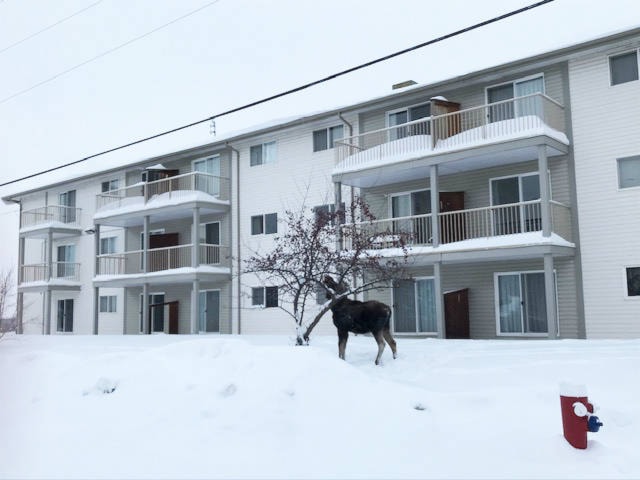Update at 4:20 pm
The Moose calf that was tranquilized and moved out of Vanderhoof today is dead, BC Conservation Officer said.
Amber Elliott, conservation officer in Vanderhoof said she confirmed with their provincial veterinarian who told her that the calf likely died as a result of stress due to the anaesthesia, “and move of an animal who was already in a somewhat compromised body condition due to the time of the year and being orphaned.”
Original story
An orphaned Moose calf that was roaming the streets of Vanderhoof has now been tranquilized and moved, because residents could not keep their distance, says a BC Conservation Officer.
Most of Vanderhoof knew about this calf either through Facebook or in-person.
‘She’ first appeared at Silvermill Apartments in Vanderhoof six to eight weeks ago, says Amber Elliott, BC Conservation Officer in the district.
Elliott says the animal was orphaned earlier than a Moose should be. “They normally stay with their mother for a full year and sometimes beyond that if the mother doesn’t get bred. But she was orphaned at seven months of age, which is quite early.”
BC Conservation Officers were informed of the calf hanging out at Silvermill Apartments and at that time they moved her from the doorway, “just to prevent someone coming out and stepping on her.”
Elliott said they made an assessment and found that she had no aggression and that her bodily condition was ‘quite good’ for a young Moose.
As a result, conservation officers made a decision to leave her in Vanderhoof and inform the public about why she was around.
“We told people that she was orphaned and is staying here because there are no predators in town. She can easily walk on the streets as there is no snow. We very strongly believe that she would have left town once Spring came because she would have matured. But we also told residents to keep their distance, because it is a wild animal,” Elliott added.
However, over the last couple of weeks, conservation officers in the district observed that people were getting quite close to the proximity of the calf. Elliott said they tried reaching out to people through their Facebook page to provide that public education to not approach the animal, but that didn’t work.
And then, on Thursday March 12, some people decided to hand feed the wild animal and got kicked as a result, Elliott said.
“So the Moose made contact with someone’s hand, they went to the hospital and it was a non-serious injury, but there was some bruising.”
“But as a result of that, there has been contact between wildlife and a human and our priority is always the public safety aspect of things. And because our public messaging is not working at this time, we are going to have to try and move that Moose which is not without risk either,” Elliott explained.
The risk Elliott is speaking about is how the animal will react to being tranquilized. She said there is a common misconception that when an animal is tranquilized, they immediately ‘go out’.
That is not the case.
“From the second the dart leaves our gun and enters the muscle of the Moose, several minutes pass before the tranquilizer takes effect. And at that time, it has become a dynamic situation, because we cannot control what the Moose does in that time frame of when the dart hits it and when it goes out,” Elliott said.
VIDEO: We’re not ‘cold-blooded killers’ of bears, B.C. conservation officer says
READ MORE: Bald eagle hit by train in Vanderhoof has a chance of survival
Because the animal can feel pressured, due to people being around, the situation escalates because the calf is then feeling pain and their instinct is to become defensive or try to escape.
Another risk for the young Moose is that she may get Capture Myopathy as a result of the tranquilizer. Capture Myopathy, Elliott explained, is where the animal gets a sudden onset of illness which causes muscle issues in the animal and can cause death from being captured or tranquilized.
For future references, Elliott said the reason people are at-risk and the reason why this Moose calf is now at-risk is because people were unable to keep their distance and “didn’t let the wildlife stay wild.”
Do not feed wildlife, whether it is Deer, Coyotes, Bears, Moose, she said, adding that people need to keep their distance from wild animals because otherwise they put themselves and the animal at-risk.
To report unusual wildlife sightings or any potentially dangerous wildlife encounters or any situation where you want to report a poacher, call 1-877-952-RAPP.
Aman Parhar
Editor, Vanderhoof Omineca Express
aman.parhar@ominecaexpress.com
Like us on Facebook and follow us on Twitter
